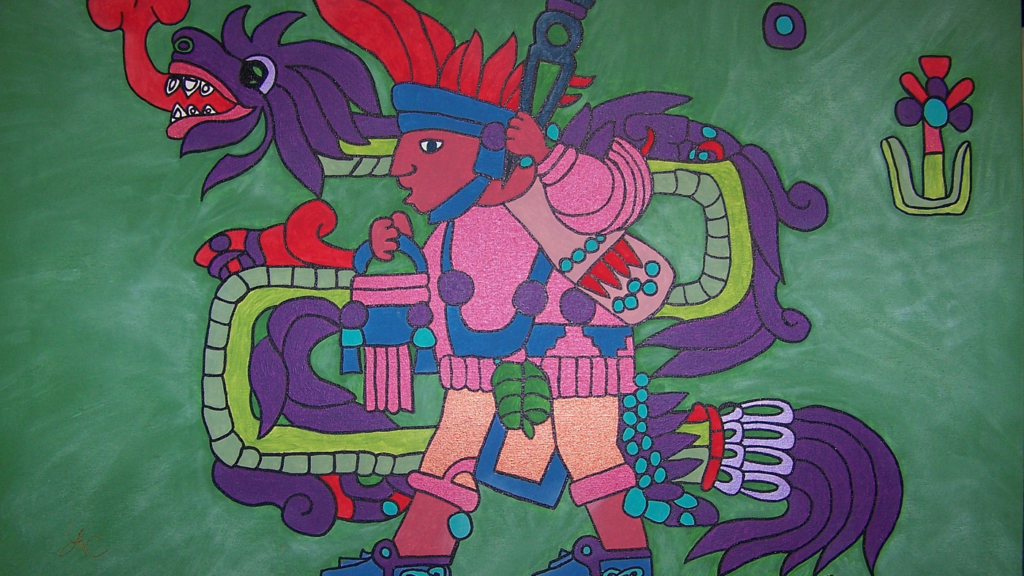Quetzalcoatl, the feathered serpent deity, holds a prominent place in the rich tapestry of Mesoamerican mythology. Revered by the Aztecs and other civilizations, Quetzalcoatl’s significance transcends time and cultural boundaries. This article will delve into the roles and myths associated with Quetzalcoatl, exploring his role in Aztec cosmology, his portrayal as a trickster god, his involvement in the creation of the universe, and the enigmatic legend of his possible return as Hernan Cortes, the Spanish conquistador. By exploring these facets of Quetzalcoatl’s existence, we can gain a deeper understanding of his multifaceted nature and his lasting impact on Mesoamerican civilization.
Quetzalcoatl’s Role in Aztec Cosmology
Creation of Humanity and Staple Crops
One of Quetzalcoatl’s most significant roles in Aztec mythology is his involvement in the creation of humanity and the provision of staple crops. According to myth, Quetzalcoatl and his brother, Tezcatlipoca, descended into the underworld and gathered the bones of the previous race of beings. They mixed the bones with their own blood, creating the first man and woman.
In addition to creating humanity, Quetzalcoatl is also credited with discovering maize, the staple crop of the Aztec people. In the myth, Quetzalcoatl descended into the underworld and stole the bones of the previous races. These bones were ground into a fine powder, and with the addition of Quetzalcoatl’s blood, they transformed into the first ears of maize. This remarkable act of creation solidified Quetzalcoatl’s position as a benefactor and provider for humanity.
Trickster God
Although Quetzalcoatl is often revered as a benevolent god, he also possesses characteristics of a trickster deity. In Mesoamerican mythology, trickster gods play an important role in shaping the world and human civilization through their cunning and mischievous actions. Quetzalcoatl is no exception to this archetype.
Throughout various myths, Quetzalcoatl is depicted playing tricks or outsmarting other gods for the benefit of humanity. One such myth tells the story of how Quetzalcoatl tricked the god of the underworld, Mictlantecuhtli, into allowing him to retrieve the bones necessary for the creation of humanity. Through quick thinking and clever negotiation, Quetzalcoatl successfully fooled Mictlantecuhtli, enabling the creation of humans and subsequent civilization.
Quetzalcoatl and the Creation of the Universe
Quetzalcoatl’s involvement in the creation of the universe further solidifies his status as a central figure in Aztec cosmology. According to myth, Quetzalcoatl and his twin brother, Tezcatlipoca, played a pivotal role in the creation of the cosmos.
In one myth, Quetzalcoatl and Tezcatlipoca created the first fire, a partial sun, and the first man and woman. They sacrificed themselves in order to provide the necessary energy for the creation process. After their sacrifice, Quetzalcoatl and Tezcatlipoca ascended to the heavens, becoming stars and guiding the destiny of the newly formed world.
The Life of Topiltzin-Quetzalcoatl
Wise Rule in the City of Tula
One of the most intriguing aspects of Quetzalcoatl’s mythological legacy is the historical figure known as Topiltzin-Quetzalcoatl. Topiltzin-Quetzalcoatl, also known as One-Reed, was a ruler in the city of Tula during the 10th century CE. He was believed to possess the spirit of Quetzalcoatl and ruled with wisdom and benevolence.
During his rule, Topiltzin-Quetzalcoatl implemented various reforms and advancements that had a transformative impact on the city of Tula. He promoted the arts, agriculture, trade, and education. His wise rule and dedication to the betterment of his people earned him a reputation as a just and virtuous leader.
Rivalry with Tezcatlipoca and Departure from Tula
However, Topiltzin-Quetzalcoatl’s rule was not without challenges. His rivalry with Tezcatlipoca, the god of darkness, brought about a series of events that ultimately led to his departure from Tula. Tezcatlipoca, jealous of Topiltzin-Quetzalcoatl’s popularity, devised a plan to discredit him and force him to leave.
In one version of the story, Tezcatlipoca presented Topiltzin-Quetzalcoatl with various tests and temptations, causing him to deviate from his virtuous path. When his people discovered his actions, they turned against him, and he was forced to leave Tula in disgrace.
The various versions of Topiltzin-Quetzalcoatl’s departure from Tula also include the possibility of self-cremation or descent into the underworld. These versions highlight the mythical and mysterious nature of Quetzalcoatl’s character and the ambiguity surrounding his demise.
The Legend of Cortes as the Second Coming of Quetzalcoatl
Historical Context and Debunking the Myth
The legend that Hernan Cortes, the Spanish conquistador, was the second coming of Quetzalcoatl is a fascinating aspect of Quetzalcoatl’s mythology. This belief emerged during the Spanish conquest of the Aztec Empire and was propagated by Spanish writers, particularly Fray Bernardino de Sahagún.
However, it is important to understand this myth within its historical context. The Spanish conquest of the Aztec Empire was a tumultuous period marked by violence, disease, and cultural upheaval. The Aztecs, devastated by the arrival of the Spanish and the introduction of new diseases, sought to make sense of the events unfolding around them.
Spanish writers, motivated by the desire to legitimize their conquest and convert the indigenous population, created the myth of Cortes as the second coming of Quetzalcoatl. This myth served as a powerful tool to assert Spanish dominance and portray the Spanish crown as fulfilling ancient prophecies.
Conclusion
Quetzalcoatl, the feathered serpent deity, is a complex and enigmatic figure in Mesoamerican mythology. His mythological roles encompass creation, trickery, and wise leadership. The legendary figure of Topiltzin-Quetzalcoatl exemplifies the lasting impact of Quetzalcoatl in history, while the myth of Cortes as the second coming of Quetzalcoatl highlights the cultural and political dynamics of the Spanish conquest.
Through his various roles and narratives, Quetzalcoatl remains a captivating and enduring figure, embodying the rich mythology and cultural heritage of Mesoamerica.
